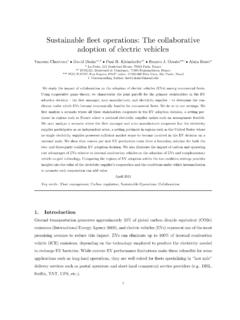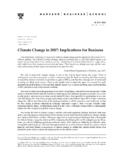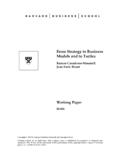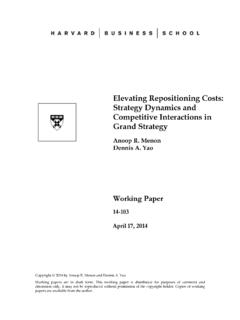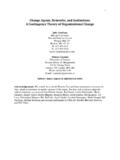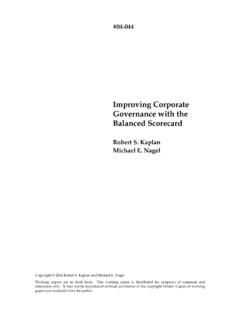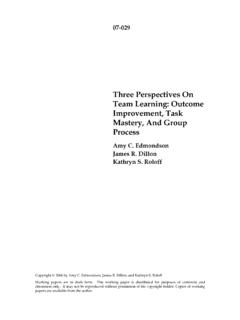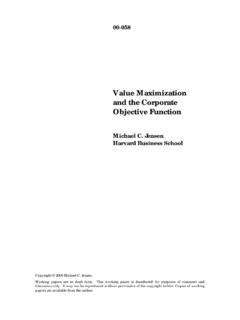Transcription of Conceptual Foundations of the Balanced Scorecard 3.17.10
1 Copyright 2010 by Robert S. Kaplan Working papers are in draft form. This working paper is distributed for purposes of comment and discussion only. It may not be reproduced without permission of the copyright holder. Copies of working papers are available from the author. Conceptual Foundations of the Balanced Scorecard Robert S. Kaplan Working Paper 10-074 1 Conceptual Foundations of the Balanced Scorecard1 Robert S. Kaplan Harvard Business School, Harvard University 1 Paper originally prepared for C. Chapman, A. Hopwood, and M. Shields (eds.), Handbook of Management Accounting Research: Volume 3 (Elsevier, 2009). 2 Conceptual Foundations of the Balanced Scorecard Abstract David Norton and I introduced the Balanced Scorecard in a 1992 Harvard Business Review article (Kaplan & Norton, 1992). The article was based on a multi-company research project to study performance measurement in companies whose intangible assets played a central role in value creation (Nolan Norton Institute, 1991).
2 Norton and I believed that if companies were to improve the management of their intangible assets, they had to integrate the measurement of intangible assets into their management systems. After publication of the 1992 HBR article , several companies quickly adopted the Balanced Scorecard giving us deeper and broader insights into its power and potential. During the next 15 years, as it was adopted by thousands of private, public, and nonprofit enterprises around the world, we extended and broadened the concept into a management tool for describing, communicating and implementing strategy. This paper describes the roots and motivation for the original Balanced Scorecard article as well as the subsequent innovations that connected it to a larger management literature. 3 Conceptual Foundations of the Balanced Scorecard Robert S. Kaplan David Norton and I introduced the Balanced Scorecard in a 1992 Harvard Business Review The article was based on a 1990 Nolan, Norton multi-company research project that studied performance measurement in companies whose intangible assets played a central role in value Our interest in measurement for driving performance improvements arose from a belief articulated more than a century earlier by a prominent British scientist, Lord Kelvin:3 I often say that when you can measure what you are speaking about, and express it in numbers, you know something about it; but when you cannot measure it, when you cannot express it in numbers, your knowledge is of a meager and unsatisfactory kind.
3 If you can not measure it, you can not improve it. Norton and I believed that measurement was as fundamental to managers as it was for scientists. If companies were to improve the management of their intangible assets, they had to integrate the measurement of intangible assets into their management systems. After publication of the 1992 HBR article , several companies quickly adopted the Balanced Scorecard giving us deeper and broader insights into its power and potential. During the next 15 years, as it was adopted by thousands of private, public, and nonprofit enterprises around the world, we extended and broadened the concept into a management tool for describing, communicating and implementing strategy. In this paper, I describe the roots and motivation for the original Balanced Scorecard article as well as the subsequent innovations that connected it to a larger management literature. The paper uses the following structure for organizing the origin and subsequent development of the Balanced Scorecard : 1.
4 Balanced Scorecard for Performance Measurement 2. Strategic Objectives and Strategy Maps 3. The Strategy Management System 4. Future Opportunities 4 Balanced Scorecard for Performance Measurement Figure 1 shows the original structure for the Balanced Scorecard (BSC). The BSC retains financial metrics as the ultimate outcome measures for company success, but supplements these with metrics from three additional perspectives customer, internal process, and learning and growth that we proposed as the drivers for creating long-term shareholder value. Figure 1: Translating Vision and Strategy: Four PerspectivesVision andStrategyObjectivesMeasuresTargetsInit iativesFINANCIAL To succeed financially, how should we appear to our shareholders? ObjectivesMeasuresTargetsInitiativesLEAR NING AND GROWTH To achieve our vision, how will we sustain our ability to change and improve? ObjectivesMeasuresTargetsInitiativesCUST OMER To achieve our vision, how should we appear to our customers?
5 ObjectivesMeasuresTargetsInitiativesINTE RNAL BUSINESS PROCESS To satisfy our shareholders and customers, what business processes must we excel at? Historical Roots: 1950-1980 The Balanced Scorecard , of course, was not original for advocating that nonfinancial measures be used to motivate, measure, and evaluate company performance. In the 1950s, a General Electric corporate staff group conducted a project to develop performance measures for 5 GE s decentralized business units (Lewis, 1955).2 The project team recommended that divisional performance be measured by one financial and seven nonfinancial metrics. 1. Profitability (measured by residual income) 2. Market share 3. Productivity 4. Product leadership 5. Public responsibility (legal and ethical behavior, and responsibility to stakeholders including shareholders, vendors, dealers, distributors, and communities) 6. Personnel development 7. Employee attitudes 8.
6 Balance between short-range and long-range objectives One can see the roots of the Balanced Scorecard in these eight objectives. The financial perspective is represented by the first GE metric, the customer perspective with the second, the process perspective with metrics 3 -5, and the learning and growth perspective with metrics 6 and 7. The 8th metric captures the essence of the Balance Scorecard , encouraging managers to achieve a proper balance between short and long-range objectives. Unfortunately, the noble goals of the 1950s GE corporate project never got ingrained into the management system and incentive structure of GE s line business units. In fact, despite metrics 5 and 8 in the above list, several GE units were subsequently convicted of price-fixing schemes, with their managers claiming that corporate pressure for short-term profits led them to compromise long-term objectives and their public responsibilities.
7 At about the same time as the GE project, Herb Simon and several colleagues at the newly-formed Graduate School of Industrial Administration, Carnegie Institute of Technology (later Carnegie-Mellon University) identified several purposes for accounting information in organizations: Scorecard questions: Am I doing well or badly? Attention-directing questions: What problems should I look into? Problem-solving questions: Of the several ways of doing the job, which is the best? 2 See also, General Electric (A), HBS Case Study 6 Simon and his colleagues explored the role for financial and nonfinancial information to inform these three questions. This study was perhaps the first to introduce the term Scorecard into the performance management discussion. Peter Drucker introduced management by objectives in his classic 1954 book, The Practice of Management.
8 Drucker argued that all employees should have personal performance objectives that aligned strongly to the company strategy: Each manager, from the big boss down to the production foreman or the chief clerk, needs clearly spelled-out objectives. These objectives should lay out what performance the man s [sic] own managerial unit is supposed to produce. They should lay out what contribution he and his unit are expected to make to help other units obtain their objectives. [..] These objectives should always derive from the goals of the business enterprise. [..] [M]anagers must understand that business results depend on a balance of efforts and results in a number of areas. [..] Every manager should responsibly participate in the development of the objectives of the higher unit of which his is a part. [..] He must know and understand the ultimate business goals, what is expected of him and why, what he will be measured against and how (Drucker 1954, pp.)
9 126-9). Despite Drucker s insights and urgings, however, management by objectives in the next half-century mostly became a somewhat bureaucratic exercise, administered by the human resources department, based on local goal-setting that was operational and tactical, and rarely informed by business-level strategies and objectives. Companies at Drucker s time and for many years thereafter lacked a clear way of describing and communicating top-level strategy in a way that middle managers and front-line employees could understand and internalize. In the mid-1960s, Robert Anthony, building upon the decade-earlier research by Simon et al, and on another article by Simon on programmed versus nonprogrammed decisions, proposed a comprehensive framework for planning and control systems. Anthony identified three different types of systems: strategic planning, management control, and operational control.
10 Strategic planning was defined as: the process of deciding upon objectives, on changes in these objectives, on the resources used to attain these objectives, and on the policies that are to govern the acquisition, use, and disposition of these resources (Anthony 1965, ). Foreshadowing the subsequent development of strategy maps, Anthony claimed that strategic planning depends on an estimate of a cause-and-effect relationship between a course of action and a desired outcome, but concluded that, because of the difficulty of predicting such a relationship, strategic planning is an art, not a science. Further, Anthony noted that strategic 7 planning is not accompanied by what we would today call strategic control, Although strategic revision is important, top management spends relatively little time in this activity. Anthony also believed that information for strategic planning usually had a financial emphasis.
